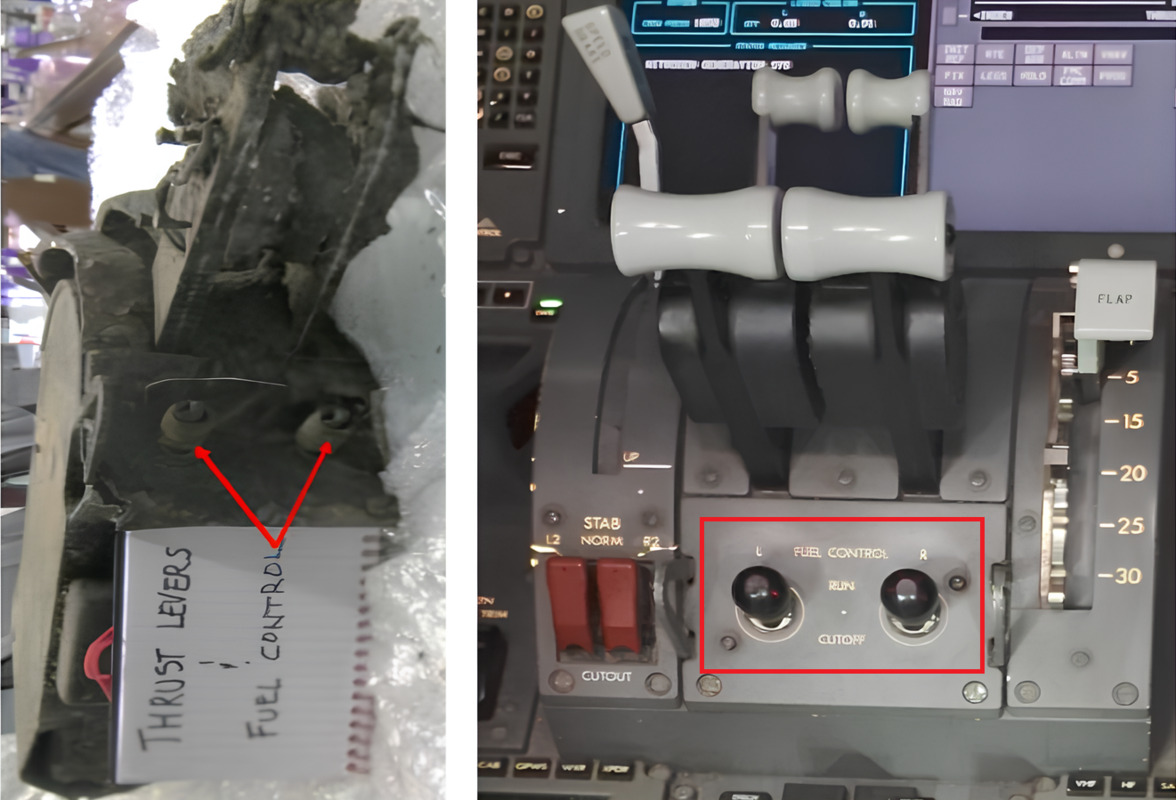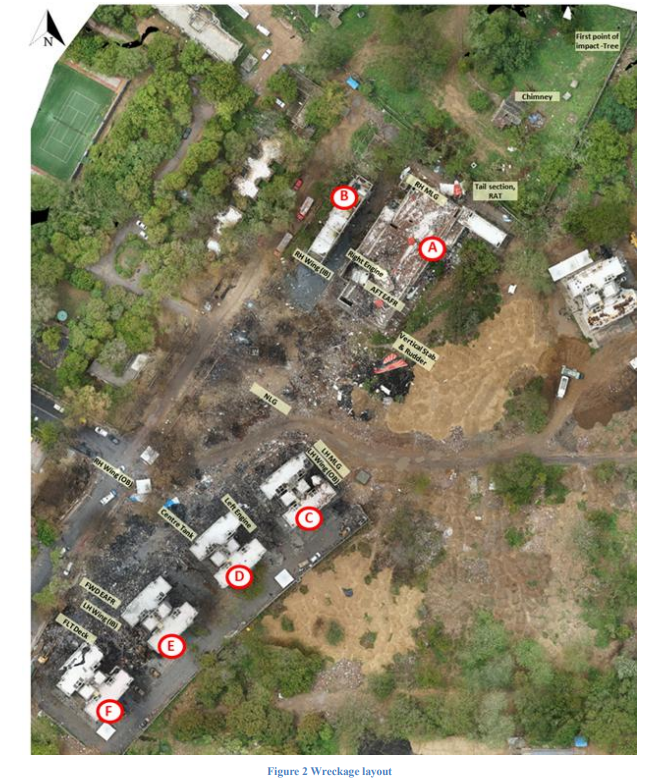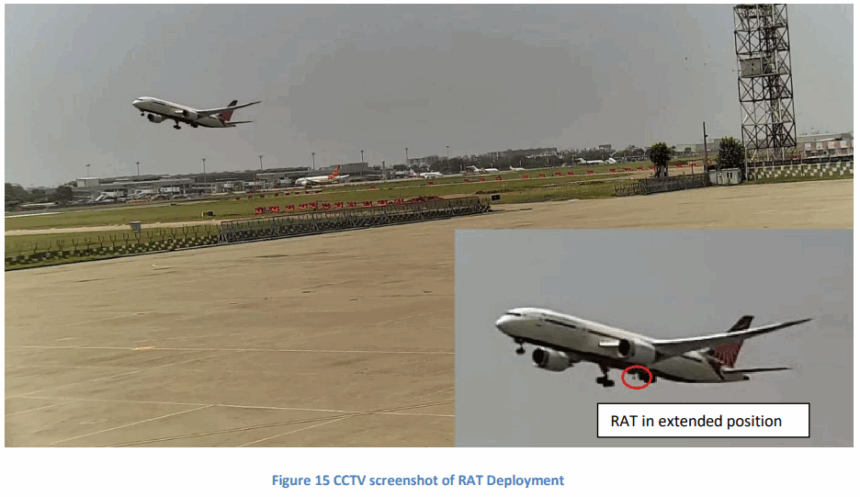 |
| Photo Source: AAIB Preliminary Report |
India’s Aircraft Accident Investigation Bureau (AAIB) has released a preliminary report detailing the tragic crash of Air India flight AI171.
The report provides critical insights into the sequence of events leading to the accident, based on data from the Enhanced Airborne Flight Recorder (EAFR), cockpit voice recordings, and physical evidence recovered from the wreckage.
This article summarizes the AAIB preliminary report findings, detailing the technical and operational aspects of the accident.
According to the AAIB report, the aircraft reached a maximum recorded airspeed of 180 knots Indicated Airspeed (IAS) at approximately 08:08:42 UTC during its takeoff phase.
Fuel Control Switches in CUTOFF Position
Almost immediately, a critical malfunction occurred: both Engine 1 and Engine 2 fuel cutoff switches moved from the “RUN” to “CUTOFF” position within a one-second interval.
This action halted fuel supply to the engines, causing the engine speeds (N1 and N2) to drop from their takeoff values.
The cockpit voice recording captured a moment of confusion, with one pilot questioning the other about activating the fuel cutoff switches.
The second pilot denied doing so, suggesting the switch activation may have been unintentional or caused by a system error.
Engine Power Loss & Subsequent Relight
As the engines lost power, the aircraft’s systems responded. By 08:08:47 UTC, the Ram Air Turbine (RAT) hydraulic pump activated to provide hydraulic power, compensating for the loss of engine-driven systems.
The EAFR data shows that at 08:08:52 UTC, the Engine 1 fuel cutoff switch was moved back to the “RUN” position. This was then followed by Engine 2 at 08:08:56 UTC.
When fuel control switches are returned to “RUN” during flight, the Full Authority Digital Engine Control (FADEC) system initiates an automatic relight and thrust recovery sequence.
The report indicates that Engine 1 began to recover. The engine’s core speed was stabilizing and exhaust gas temperature (EGT) rising, signaling a successful relight.
Engine 2, however, struggled. Although it relit, it could not sustain core speed acceleration, requiring repeated fuel reintroduction to attempt recovery.
Mayday Call Issued
The EAFR stopped recording at 08:09:11 UTC, leaving some gaps in the final moments of the flight. At 08:09:05 UTC, one of the pilots transmitted a distress call: “MAYDAY MAYDAY MAYDAY.”
The Air Traffic Control Officer (ATCO) requested the flight’s call sign but received no response. The ATCO then observed the aircraft crashing outside the airport boundary and promptly activated the emergency response.
By 08:14:44 UTC, the Crash Fire Tender, supported by local fire and rescue services, left the airport. The assets then carried out rescue and firefighting operations.
Physical Evidence from the Wreckage
The wreckage provided further clues about the aircraft’s configuration at the time of impact.
Flaps Set for Takeoff; Gear Selected DOWN
The flap handle assembly was heavily damaged by fire (see above). It was found in the 5-degree flap down position, consistent with a standard takeoff setting. This was corroborated by EAFR data.
The landing gear lever was in the “DOWN” position, indicating the gear was likely extended. It is unclear if this was intentional or a result of the emergency.
The thrust lever quadrant also sustained significant thermal damage. Both thrust levers were found near the idle position. The EAFR data revealed that they remained in the takeoff thrust position until impact. This suggests the physical position of the levers was altered post-crash.
Fuel Control Switches in RUN Position
Both fuel control switches were found in the “RUN” position, aligning with the pilots’ attempts to restore engine power. The thrust reverser levers were bent but stowed, and the wiring for the Takeoff/Go-Around (TO/GA) switches and autothrottle disconnect switches was heavily damaged.
Ongoing Investigation
The AAIB’s preliminary report does not pinpoint the exact cause of the fuel cutoff switch activation, which now remains a critical focus of the investigation.
Whether it was a mechanical failure, human error, or a combination of factors is still under review.
The sudden loss of engine power, followed by partial recovery, likely contributed to the aircraft’s inability to maintain controlled flight, leading to the crash.
The AAIB continues to analyze the wreckage, flight data, and cockpit recordings to provide a comprehensive final report.
For now, the aviation community and the public await further details to understand the full scope of this tragedy. The focus on just what caused the temporary selection of the Fuel Cutoff Selectors to the OFF position will be critical.
Courtesy & source; Aviation Source
https://aviationsourcenews.com/air-india-crash-preliminary-report-finds-fuel-switches-were-set-to-off-before-crash/#fuel-control-switches-in-cutoff-position











